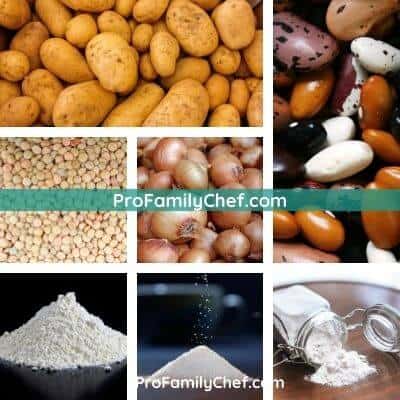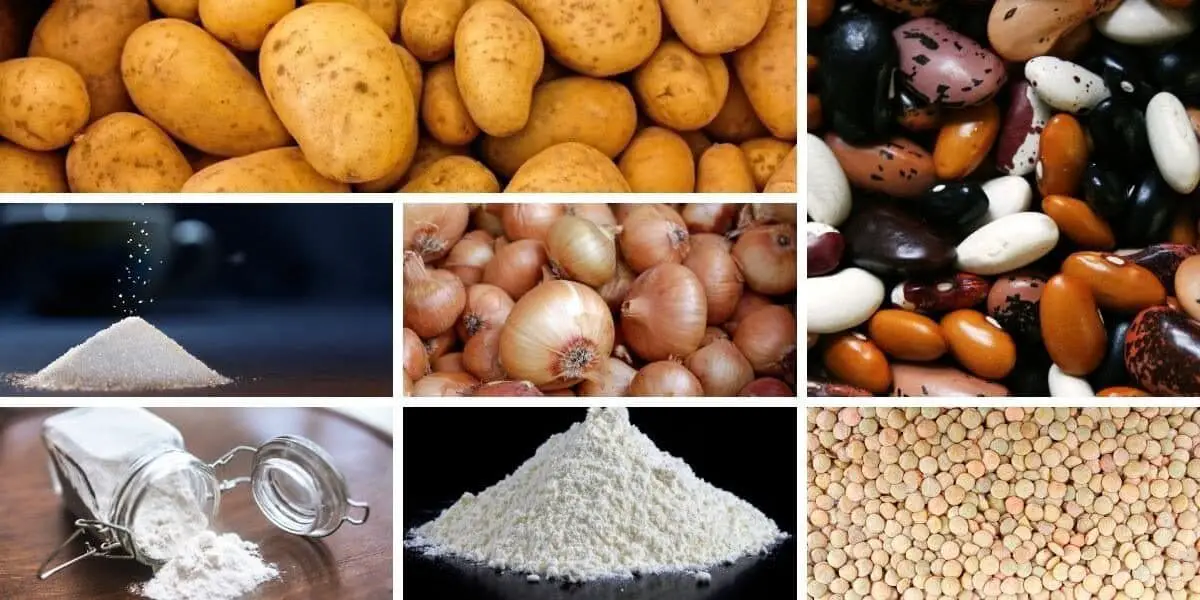All the professors in my culinary school taught me to thicken sauces with either flour or cornstarch, occasionally potato, but that was it.
Since I am continually learning and developing new recipes, I found many ways to thicken sauces, soups, or stews, without adding a pinch of flour.
I want to share these discoveries with everyone so you can benefit from them and implement diversity in your home cooking.
Using alternative ingredients or cooking techniques to thicken your sauce or soup is a great and healthy way to replace flour and cornstarch. Here is how to thicken sauce without flour or cornstarch in a nutshell:
Cooking techniques to thicken sauce or soup without flour or cornstarch
- Reduction
- Slow cooking
Ingredients to thicken sauce or soup without flour or cornstarch
- Potato
- Lentils
- Beans
- Onions
- Xanthan gum
- Gelatin
- Arrowroot powder
Best ingredients for thickening your food without flour or cornstarch

Potato
Potatoes are very starchy vegetables that can thicken almost anything. From sauce to soup or stew.
The best way to use potatoes as a thickening agent is to cut potatoes into small cubes or grate them.
The other way is to grate them. This is what I prefer and most often use. First, you get a box grater or any other tool and great potatoes as fine as possible. If you grate them finely, starch will be quickly released into the dish. It will thicken the liquid dish quickly, and you won’t have to cook it for a long time. You can use finely grated potatoes in any dish that goes well with potatoes.
If you cut them into small cubes, they are perfect if you use them in stews. The starch will be released into the dish after a while, so it is best to use them in dishes that take longer to cook.
You could also use evaporated store-bought potatoes and thicken with them. Since these are pre-made, some variants could include flour or cornstarch.
Lentils
Lentils are a very healthy substitute for thickening instead of flour and cornstarch. Dishes that work very well with lentils are soups and stews.
The best way to use them is to either cook them in the dish or pre-cook them. The best lentils for this method are red lentils.
If you use the pre-cooked method, it is essential to cook them thoroughly. Use a hand immersion blender and blend the lentils until you get a paste-like consistency. If needed, add a little water to blend easier. Use this paste in soups and stews when you want to thicken them. You can also store the paste in an airtight container in the refrigerator for at least 4 days.
The other way is to put uncooked lentils directly in the soup. If you want to thicken the soup without blending it, then add the lentils right at the beginning of cooking. This way, the lentils will have time to dissolve in soup completely.
You can also cook the lentils with other veggies and blend the soup once the lentils have cooked.
Beans
Beans are also a great substitute to thicken sauce or stew without flour or cornstarch. The thickening method is similar to lentils.
If you use canned beans, you can just blend them with some water and put the mixture into your favorite sauce or soup.
But if you use dry kidney, red or other beans, then you need to soak them first overnight. The next day, cook them in salted water until they are well done. Use a blender and make a paste. The bean paste is excellent for sauces, soups, or winter stews.
Onions
You wouldn’t expect onion to be a thickening agent, but it is one of the most versatile ingredients you could use. The trick is to use many of them and pre-cook or fry them, so they get nice and soft.
If you make a sauce, you should fry a “tone” of onions until they are caramelized. You can achieve this by frying them for a long time and by adding salt and a splash of water from time to time. In the end, blend onions thoroughly and start adding other ingredients. Onions work like flour. They thicken the sauce, make it silky, and at the same time, give a sweet and caramelized flavor.
Xanthan gum
Xanthan gum is actually an additive. It works similar to cornstarch. You mix it with your desired sauce or liquid, and it makes a sort of gluey consistency. It is gaining popularity since the rise of gluten-free dieting.
It is mostly used for thickening sauces, but you could add it also to other dishes.
How to use xanthan gum instead of flour in a recipe:
Slice different vegetables into a roasting pan. You don’t need to peel them. Simply use a mandoline slicer like this and slice as thin as possible:
Use carrots, beetroot, celery, onions, broccoli, cauliflower, eggplant, garlic, tomatoes. Add in some salt and olive oil and mix. Put everything in the oven and bake for around 40-50 minutes at 340-370F (170-190C) until you get a brownish color on your veggies. You need the brown color to get the flavor. When done, add water. Water should cover the ingredients completely.
Put it back in the oven for half an hour. When done, strain everything through a sift, and you are left with a tasty brown liquid. Take some of the liquid and make a roux with xanthan gum. Mix it with the rest of the liquid to get the desired thickens.
Gelatin
Gelatin is carb-free and perfect for the keto diet. It usually comes in powder form. To use it, simply mix it with water and add it to the desired dish.
Arrowroot powder
You can use arrowroot powder in backing or for thickening your sauce. It is a starchy powder that can be used the same way as flour can.
Best cooking techniques for thickening your food without flour or cornstarch

Reduction
Reduction is one way to thicken your sauce without adding flour or cornstarch. It is mostly used with sauces. Let’s say you are making a stake in a stainless steel pan. The stake protein will stick to the bottom of the pan, forming brown caramelized bits and pieces. When you are done with the stake, splash some cognac or wine into the pan.
The added liquid will dissolve caramelized pieces, and you will be left with a very liquidy texture of the sauce. Now it’s time to reduce this liquid.
Leave the pan on the stove and use enough heat, so the liquid boils consistently. After a few minutes, the sauce will start to thicken. Cook it until you get the desired thickness.
Slow cooking
Slow cooking is perfect if you don’t want to add flour or cornstarch. Make sure you put in your slow cooker, a simple pot or dutch oven, enough veggies, onions, and meat and leave it on for at least 4-6 hours. Control the low temperature, so the ingredients gently simmer all the time. When done, you will be left with a sauce full of flavor and just the right thickness.
How to thicken tomato sauce without flour or cornstarch
Tomato sauce is very popular in every household. But what if you want to thicken it without using flour or cornstarch. The easiest and most delicious way to thicken it is to use onions, a lot of them.
Start with frying the onions on some olive oil, and when they start to change color, add salt. Salt will soften the onions even more. Stew onions for a long time and use just enough heat so they can turn brown and caramelize. Caramelization will give that sweet flavor that you are searching for. From time to time, add a splash of water if the onions start to stick to the bottom of the pan. The sticking part is necessary if you want to get more flavor.
When onions are done, use an immersion hand blender and blend onions until you get a smooth paste-like consistency. Add the rest of the ingredients (tomatoes, basil, pepper…) and cook until the tomato water evaporates. When the sauce gets thick enough to your taste, you are done.
The trick is to add a lot of onions and skip the flour; this is how curries are made.
Conclusion
There are a lot of alternatives when it comes to thickening your sauce without cornstarch or flour. The best ones are the ones that have the most starch and can be used in most dishes.
But since the rise of gluten-free diets, some of them have gained popularity. They are also easier accessible than in the past, like xanthan gum or arrowroot powder. But it doesn’t matter if you want to eat gluten-free or not; alternatives for replacing flour or cornstarch in the sauce are easily accessible almost everywhere.
* The prices for ingredients and products in our tables are average prices take from various websites. The prices are not taken directly from Amazon.
* Pro family chef utilizes affiliate links, which means that if you click on one of our product links, Pro family chef will receive a small commission at no cost to you. This helps support us, and allows us to keep providing tips, reviews, guides, and content for you.


